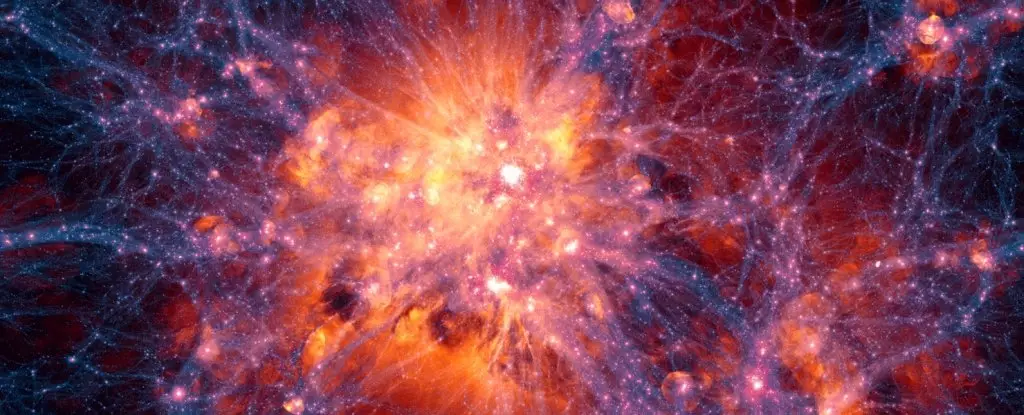The mathematical framework established by Albert Einstein in the early 20th century continues to profoundly influence our understanding of the Universe. General relativity, as it is known, has emerged as a robust model for describing gravitational phenomena in both local and cosmic settings. Recent contributions from a vast array of astronomers have further solidified this framework, as they conducted one of the most comprehensive examinations of cosmic evolution to date. The results depict the distribution of approximately 6 million galaxies over a timespan extending 11 billion years, painting a vivid picture of the interplay between gravitational attraction and the Universe’s expansion.
The study represents perhaps the most extensive validation of general relativity to date, covering nearly the entirety of the Universe’s 13.8 billion-year history. Importantly, the findings align with Einstein’s predictions, confirming that his theories hold as powerfully at colossal scales as they do within the confines of our solar system. This latest endeavor, a collaboration involving extensive work from the Dark Energy Spectroscopic Instrument (DESI), has unearthed remarkable insights into the formation and distribution of cosmic structures governed by gravitational dynamics.
The crux of this monumental exploration revolves around the cosmic web, a vast architecture where galaxies are located along gravitational strands shaped primarily by dark matter. By mapping the growth and evolutionary trajectory of galaxies, the researchers effectively validated a longstanding premise of general relativity: that the gravitational attraction among mass-rich objects shapes cosmic structures over time. This insight bears strategic implications for understanding the evolution of the Universe, as it continues to expand outward.
According to cosmologist Pauline Zarrouk from the French National Center for Scientific Research, verifying the applicability of their assumptions at such large scales was essential. “Studying the rate at which galaxies formed allows us to test our theories directly,” Zarrouk stated. The findings resonate strongly with existing predictions made by general relativity, painting a coherent picture of cosmic growth against the somewhat paradoxical backdrop of an ever-expanding Universe.
The techniques employed during this survey capitalize on the DESI collaboration’s ability to pull from substantial datasets. Since its inception in 2019, DESI has been operationally focused on charting the observable Universe, yielding substantial contributions toward unraveling cosmological enigmas. This latest analysis stems from the instrument’s inaugural year of data collection, representing a painstaking survey of 5.7 million galaxies and quasars throughout the Universe’s history.
Gravity remains a fundamental force shaping our reality, but it is shrouded in mysteries that provoke scientific inquiry. Although we understand that mass attracts mass, the underlying fabric and origin of this force continue to elude us. Current theories posit that a significant portion of the Universe’s structure is poised on dark matter, serving as the invisible glue that binds visible galaxies within a network of gravitational filaments. This dark matter constitutes about 25% of the Universe, while a further 70% is attributed to dark energy—an enigmatic force driving the accelerated expansion of cosmic realms.
As researchers strive to uncover the characteristics of both dark matter and dark energy, they remain aware that discovering incongruities in general relativity could provide insights into reconciling classical physics with quantum mechanics—one of the notable challenges in contemporary theoretical physics. According to physicist Mark Maus from the Lawrence Berkeley National Laboratory, this dual nature of dark components represents open questions fundamental to the structure and trajectory of the Universe.
The journey to unveil the mysteries of the cosmos is far from over. The DESI collaboration continues to analyze data accrued during its first three years, with aspirations of expanding their cosmic survey to encompass over 40 million galaxies and quasars. Each new piece of data contributes to a broader understanding of the natural forces sculpting the Universe; the ongoing efforts to examine cosmic structure may also unearth fresh revelations about neutrinos, providing constraints on these elusive particles whose mass remains inadequately defined.
As physicists like Dragan Huterer of the University of Michigan point out, this latest exploration has significantly enhanced our capacity to explore the nuances of gravitational models and dark energy theories. The current findings merely scratch the surface of what could be discovered through ongoing analysis. The implications of these astronomical surveys do not just hold significance for general relativity; they may eventually lead to answers that bridge established theories with emerging realms of physics, paving the way for humanity’s understanding of our cosmic existence.
The work being done today continues to honor Einstein’s legacy, pushing the boundaries of human knowledge while teasing apart the intricate tapestry of our Universe. This effort is not only a pursuit of academic excellence; it represents a deepening connection to understanding our place within the vast cosmos.

